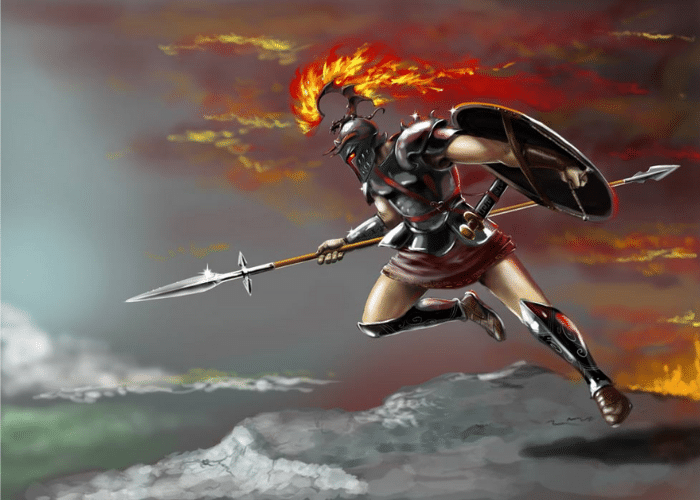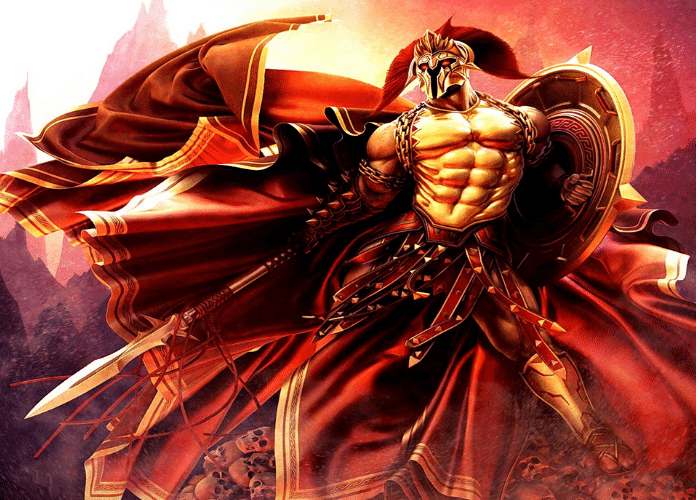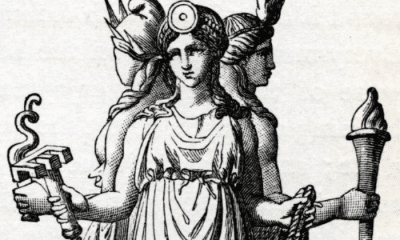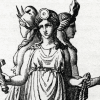
Greek
Ares: The Greek God of War
Ares: The Greek God of War
Who was the turbulent, bloodthirsty god of warfare and weaponry? Read on to find out all about Ares, the Greek god of violence and battle.
War was an almost constant reality of life in the Greek world.
The many city-states of Greece fought amongst themselves often, whether for territory or to settle disputes.
Wars were waged abroad to establish colonies or secure trade goods. Foreign invaders threatened to do the same.
Wars played a major part in Greek legends. The Trojan War and the story of Seven Against Thebes helped to form the cultural identity of the people.
Yet, war is never a pleasant thing. While the Greeks prepared and trained for it, most hoped to avoid it as much as possible.
In the pantheon of Olympus, Ares represented everything the Greeks dreaded about war. Unchecked violence, aggression, and destruction were all the god’s purview.
Ares was a god that few loved and nearly all feared.
Ares the Violent
Many of the gods and goddesses of the Greek pantheon ruled over a multitude of different domains.
Athena was the goddess of both wisdom and war. Hermes was simultaneously a messenger and a shepherd.
Ares, however, had just one true purpose.
He was, simply, the god of war.
Ares oversaw all aspects of armed conflict, from violence and blood lust to the weapons themselves. He personified the courage and strength of the mortal men who marched into battle.
When war was not being waged, he turned his attention to brigands, pirates, and cutthroats. Whenever men used violence and fought one another, it was within the purview of Ares.
Even his more tangential roles fit into this purpose. He was associated with civil order not through law and justice, but through the armed men who upheld the standards of society.
In this though, he was just as likely to be associated with militant rebellion or armed thieves as he was with the guardians of law and order. A righteous purpose mattered less to him than the violence and death of fighting itself, no matter what the cause.
While the Greek people often warred with each other and with their neighbours, aside from the famous warrior culture of Sparta they typically preferred the pursuits of peace. The Greeks valued law, art, music, and education while they dreaded war.
Even his name attests to the negative connotations of his domain. The Greek word are meant a curse or cause of ruin.
Ares was just as fearsome in the scant descriptions of his appearance. Hesiod described him as burning, such a deep shade of red that he appeared to be covered in blood before battle had even begun.
Ares represented a reality of life, but for most Greeks his attributes were not the idealized virtues of other gods.
In fact, Ares was so contrary to Greek ideals that they largely associated him with another culture altogether.
To the north of Greece lived the Thracians, a loosely-organized group of tribes regarded by the Greeks as barbaric and uncivilized.
The people of Thrace often fought the Greeks, either on their own or under the control of another empire like the Persians. Herodutus claimed that they were one of the most numerous groups of people in the known world, and only their lack of unity kept them from being a great power.
Ares was closely identified with the Thracians. He was considered their patron and the myths often have him born in Thrace or taking refuge there.
While Ares was a member of the Greek pantheon and one of the twelve original inhabitants of Olympus, the Greeks were hesitant to claim such a violent and cruel god as part of their culture. They chose, instead, to associate him with barbarians from foreign lands.
Ares the Greek God of Masculinity
Although Ares was not representative of Greek ideals, he did personify some traits that they held in high regard.
Ares was strong and courageous, qualities necessary for any man to possess in the often harsh world of the Iron Age.
While the Greeks valued education and the arts, warfare and fighting were never too far separated from daily life. Whether laying siege to another city-state or fighting off bandits and rivals at home, the Greeks saw violence as an inescapable and too often unavoidable part of life.
The few surviving hymns to Ares address the masculine attributes of the god.
He was stern and strong. He never wavered in battle or grew weary.
Ares was boisterous, but could be magnanimous in victory. He was fierce and wild, but fought for just causes and righteous vengeance.
These traits of Ares were seen as distinctly masculine. Women, on their own, had none of the vigour and strength the god bestowed upon men.
The women who were exceptions to this view of gender were almost always associated with the god. Women who fought or stood up to violent men were favored by the god, and often seen as his daughters.
The extreme masculinity of Ares was the only way to explain how a woman could come by such traits as courage and aggression.
While most men certainly hoped to avoid going to war, if they had to fight they hoped to emulate Ares.
But certain myths hint that the masculinity of Ares could be overcome by the more cultured and sophisticated ideals of Greece.
In the first Olympic Games held in honor of Zeus, Ares faced Apollo in boxing. The god of masculine strength lost to the one who exemplified the more artistic, virtuous aspects of Greek manhood.
The aggressive masculinity of Ares had its place in warfare and conflict, but in times of peace, such as the truce that marked the Olympic Games, it had less value.
Ares and Aphrodite
While Ares was known for his violent disposition, he was also a key player in one of Greek mythology’s most infamous love affairs.
Ares was most often linked to Aphrodite, the goddess of beauty and love. He had other lovers, but Aphrodite was always identified as his favorite, the consort with whom he spent the most time and to whom he showed the most affection.
Aphrodite was similarly devoted to him, overlooking his temperamental nature and unpopularity among the other gods.
While beauty and war may seem like a strange pairing, the legends of Greece often paint wars as a result of affairs and elopements.
Desire and violence were not true opposites, but were instead seen as complementary. One often led to the other, and both pushed men to extreme behaviors.
Ares and Aphrodite seemed like a perfect match. However, Aphrodite was married to someone else.
The story of Aphrodite’s marriage can only be pieced together from fragments and clues found in artwork. It begins with the birth of Hephaestus.
He may have been a son of Zeus, but other theories said that Hera bore him without the help of a man because she was so jealous that her husband had given birth to Athena without a mother’s involvement.
The god was born lame and deformed and Hera was absolutely disgusted by him. He was often shown in art with a hunched back and crooked legs, a far cry from the perfect forms preferred amongst the gods.
Hera threw her new son away, but the child was saved by Thetis and Eurynome.
While she discarded Hephaestus, Hera gave preference to the son she’d had with Zeus – Ares.
Hephaestus grew to be a skilled smith and sent gifts to Olympus, presumably to earn back a place there. His gift to his mother, however, was a trap.
When Hera sat on the gilded throne he had sent her, she was bound to the seat with invisible shackles. No one among the gods could break them to set her free.

Unable to free his wife, Zeus commanded the gods to bring back the smith. As an incentive, he offered marriage to Aphrodite as a reward for the god who could bring Hephaestus to Olympus to face judgement and free his mother.
Aphrodite agreed to the plan. She was already in love with Ares and was certain that the god of fighting could prevail over a disabled outcast.
Ares stormed the forge Hephaestus worked in, charging in as if to battle. He was repelled, though, by a shower of fiery sparks from the smith’s tools.
The violent charge of Ares failed to earn him Aphrodite’s hand.
It was finally Dionysus who was able to convince Hephaestus to come willingly, rather than force him to with strength. He used wine to make the smith more amenable.
He also offered a reward. If Hephaestus went to Olympus of his own accord, he would technically be the god who brought him in.
By the wording of Zeus’s promise, Hephaestus won the hand of the goddess of beauty when he walked into the king’s palace of his own free will.
Ares lost out in the bid to marry the beautiful goddess, but her wedding was not the end of their story. Unhappy in her marriage to an ugly god, she continued their affair.
Helios eventually caught wind of their secret trysts and alerted Hephaestus. The smith devised a plan to catch his wife and Ares in the act.
He told Aphrodite that he was leaving their home for a visit to a favorite place on earth. As soon as he walked out the door, she invited Ares to their palace.
The pair did not know that her husband had laid a trap. The moment that they went to bed together unbreakable chains fell upon them, trapping them in place.
Hephaestus called all the gods in to witness the lovers’ shame. While the goddesses demurely hid from the spectacle, the gods laughed at the humiliation of Ares and Aphrodite.
Only Poseidon seemed to show some sympathy for embarrassed lovers.
For Poseidon there was no laughing; he kept imploring the master smith Hephaistos in hopes that he would let Ares go. He spoke in words of urgent utterance : ‘Let him go; I promise that he shall pay in full such rightful penalty as you ask for–pay in the presence of all the gods.’ But the great lame craftsman answered him: ‘Poseidon, Sustainer of the Earth, do not ask this of me. Pledges for trustless folk are trustless pledges. If Ares should go his way, free of his chains and his debt alike, what then?’
-Homer, Odyssey 8. 267 ff (trans. Shewring)
Poseidon eventually convinced Hephaestus to release the couple by promising to take Ares’s punishment if the god of war misbehaved again.
The shamed pair went their separate ways, with Ares fleeing to his sanctuary in Thrace.
Ares had not only been humiliated in front of the gods, but he had been called out as a liar.
Aphrodite divorced her husband soon after the embarrassing episode. By the time of the Trojan War, Homer described her as the consort of Ares.
The two had several children together.
Stories vary as to whether or not Eros, the god of love, was their son or had a different origin. But other children of beauty and war were well-attested.
Many of these became companions of their father and joined him in battle.
The Companions of War
Ares was never alone on the battlefield.
Greek religion, and that of the Romans who came after them, personified many of the emotions and forces of the world around them.
These minor deities were often the companions and assistants of the Olympian gods they most closely mirrored.
Poseidon, for example, was served by a multitude of minor sea gods and nymphs who personified such specific parts of the ocean as dolphins, sea salt, and waves.
These companion gods were often named as the children of the divinity they served.
In the case of Ares, many of his companions were as fearsome and terrifying as he was. They included:
- Eros – The god of love, he was by many accounts the son of Ares and Aphrodite. He often led the way for his father, as love could cause conflict and, as shown with Paris and Helen of Troy, even war.
- Deimos – Another son with Aphrodite, Deimos was the personification of terror.
- Phobos – The twin brother of Deimos, his name means fear. It lives on in modern vocabulary with “phobia.”
- Nike – The winged goddess of victory, she was sometimes shown with Ares but more closely identified with Athena.
- Eris – The personification of strife, she was sometimes called the sister of Ares.
- Enyo – Sometimes conflated with Eris, her name means “hate.”
- Cydoemos – This minor god symbolized the din of war and chaos of the battlefield.
- Insidia – This Roman personification of treachery was said to guard the palace of Mars, always lurking in the shadows.
- Thanatos – Death itself was not subservient to war, but always followed closely behind it.
Although he was most generally seen as a source of fear for humans, Ares was also known to grant favor to those who he felt worthy of it. These favorites, generally great warriors, fought their battles with Ares by their side.
He was associated with the Amazons, the mythical race of female warriors. The fearsome Amazon queens were said to be his daughters.
One such queen, Hippolyte, possessed the magical belt and arrow-shooting birds of Ares. Claiming this belt from the warrior queen was one of the twelve impossible labors assigned to Heracles.
A later queen, Penthesileia, fought for her father as an ally of the Trojan army. When she was killed by Achilles, Zeus had to stop Ares from destroying the Greek army entirely in revenge.
Cadmus had to earn the god’s favor. He killed a water-dragon the god had created, and spent seven years in service to Ares to atone for the dragon’s death.
When Cadmus sowed the dragon’s teeth into the ground, they gave rise to the Spartoi, the first famed warriors of Sparta.
Cadmus eventually completed his service and married Harmonia, the daughter of Ares and Aphrodite. The pair founded Thebes and, when finally defeated, were brought to Olympus together by her father.
Harmonia, unlike most brides in Greek mythology, was noted for having fought alongside her husband.
Another version of the birth of the Spartoi was that the dragon’s teeth that made them were sown by Aeetes. He was the owner of the golden fleece featured in the legend of Jason and the Argonauts, which he had obtained after sacrificing the sheep to Ares.
His son Phlegyas was likewise a renowned fighter who battled alongside his father. He founded a northern tribe that was so warlike and ferocious that their campaigns against Greece were seen as reckless.
The kings of Thrace were also said to be descendents of Ares, reinforcing his link to the barbarous tribes.
Ares and Athena
While Ares and Athena were both deities of war, they represented very different aspects of it.
Athena’s domain was wisdom. She counseled toward careful strategies and guided generals toward making sound choices.
Ares represented the more brutal aspects of war. He was brash and violent, relying more on physical domination than wits and planning.
The two also differed in the types of battles they engaged in. Athena was associated more with the righteousness of a cause, while Ares loved fighting for its own sake.
They were also opposites in their fighting style.
Ares is generally pictured with a spear, the standard weapon of a Greek footsoldier. Athena is known for her shield, representing defense more than assault.
Unlike his half-sister, Ares was not known for inventing the tools of war and defense. A basic spear or sword was all he needed for fighting.
As a result of their different roles in warfare, veneration of the two deities was much different in ancient Greece.
Military leaders prayed to Athena for her wisdom in matters of war. Regular soldiers prayed to Ares for courage and strength in the battles their generals planned.
While Ares shared the domain of war with Athena, they represented very different aspects of the same thing.
Because of this, they were also treated very differently.
In the stories of Greece, even the gods were distrustful of Ares.
In Homer’s Iliad, Zeus tells Ares that he finds him to be the most hateful of all the gods. His love of fighting and violence were nothing but trouble in the king’s eyes.
Zeus was his father and put up with Ares for that reason. But the king of the gods tells Ares that, had he been born to any of the other gods, Zeus would have seen him expelled from Olympus long before the Trojan War.
Ares appears less often in the myths than other, more popular gods.
This is in stark contrast to Athena, who was frequently held as Zeus’s favorite child. She appeared in a variety of myths and was often associated with the other gods and goddesses of Olympus.
Aside from his mother and his wife, few of the Olympians seemed to have enjoyed the company of the god of war.
That ambivalence extended to the people of Greece as well.
The Anonymous God
Unlike many of the other gods, Ares had few major temples and few official cults.
Ares represented something most people wanted to avoid. When they did pray to or perform sacrifices to him, it was in hopes of pacifying him so that he would not pay them a visit.
Soldiers prayed to Ares before a battle, but this form of veneration was much different than the more organized cults of the other gods. Prayers to Ares did not follow a set calendar or involve complex rituals.
The one exception to this was in Sparta. Known for its warrior culture, the city-state held Ares in high regard.
Every aspect of life in Sparta centred around the city’s mighty army. Spartan boys began training for military life at a very early age, leaving home at just seven years old.
Freeborn Spartan men had no education or vocation beyond the army. To them, Ares was a model soldier who exemplified the resilience and strength they trained their whole lives for.
Spartans revered Ares far more than their peers in other regions of Greece because he, more than Apollo or Dionysus, represented the values of their city-state.
Outside of their walls, the Spartans erected a statue of Ares bound in chains. This served as a reminder that the military spirit of the god would never leave the city.
Otherwise, however, identifying statues of Ares is particularly difficult. His chief attributes, his helmet and spear, do nothing to distinguish him from other leaders and heroes.
Many works of art from ancient Greece, including sculptures and pottery, depict similar figures. Saying that any of them are Ares, however, is nearly impossible without an inscription that bears his name.
In sculpture, the shield of Ares or any of the heroes would be created from a stock type with no standard to identify the carrier.
The helmet and armor the god typically wore in art was likewise no different than that worn by any Greek soldier.
While other gods had attributes that made them immediately recognizable, it is almost impossible to visually separate Ares from any of the heroes and historical figures that followed him.
In fact, the human heroes of Greek mythology often had more identifying attributes than the god.
The result is a god with much less archaeological evidence than most others. Only one temple to Ares has been identified and few pieces of art can be said to definitely be representations of him.
His cult, as it existed outside of Sparta, was probably centered around the northern regions of Thessaly and Thrace. These are the places linked to him in the written stories.
These regions, however, represented the marginal edge of the Greek world. The people of places like Attica barely considered the people there to be Greek.
As a result, fewer geographic and cultural accounts of the northern regions that Ares was worshipped in exist. Those people were barbarous in the minds of more southern Greek people, and not worthy of note.
Thus, while we have contemporary descriptions of even forest shrines in the south, we know nothing of any temples to Ares that may have been built in his Thracian homeland.
Aside from a few writings that describe the prayers offered up to him, there is little evidence for the way Ares was worshipped in ancient Greece.
The largest temple to Ares we know of was erected on the agora in Athens. However, that was a later addition.
The temple had been moved to that area in the time of Augustus, the first Roman emperor. By that time, Greece was already well within the Roman sphere of influence and Greek gods had been adopted by the Italian power.
Ares took a much different meaning in Roman mythology.
In Rome, he was known as Mars. The early Romans, in adopting the Greek pantheon, had combined Ares with a local god of agriculture and peace.
The result was a god with a much different set of virtues and attributes.
Roman Mars represented the use of war to bring about peace. He was a force of stability and prosperity, not pure destruction.
The Romans subdued their local enemies early in their history, so unlike the Greeks they rarely faced wars close to home. Rome fought foreign enemies in order to build a prosperous empire, so the destruction of war was usually far removed from the daily life of Roman citizens.
In many parts of the empire, the military became a true peacekeeping force. Once local populations were subdued, a continued military presence kept the chance of future rebellion low.
Rome entered the Pax Romana, a period in which Rome itself and much of its territory enjoyed peace. Fighting was largely relegated to the borders as the empire expanded.
The military prowess of the empire brought wealth, not suffering, at least to the people of Rome itself. Mars came to represent the Roman cultural identity.
Unlike his predecessor, Mars had many temples and identifiable images. He was prayed to often by people from all walks of Roman life.
The Romans made Mars the father of Romulus and Remus, and this the ancestor of the Roman people themselves. Augustus took this a bit further, incorporating him into the official Imperial Cult as a direct ancestor of the Julian emperors.
Mars and Venus, the Roman equivalent of Aphrodite, were still linked. As the mother of Aeneas, another of the nation’s founders, and a female ancestor of the Julii the affair that began in Greek mythology strengthened the cultural identity of the Roman people.
Mars gives his name to a planet. His name is the root of the word “martial,” the month “March,” and the name “Martin.”
The Greek Ares, representing the brutality and suffering of constant fighting between the city-states, was transformed into a god that brought great wealth to the country that venerated him.
Ares in Defeat
Although he exemplified the ideal of a warrior who never faltered and never tired, Ares was not the most successful god in his own pursuits.
In individual fights, like those with Apollo and Hephaestus, he was defeated in nearly every recorded tale.
In the Trojan War he was persuaded by Aphrodite to join her in supporting Troy. The city fell to the superior cunning and strategy of his counterpart, Athena.
He was even bested by giants in fights. In a legend recounted in the Iliad, the two Aloadae giants were able to keep him prisoner in an urn for over a year until Hermes came to his rescue.
While the virtues Ares represented were important in battle, the Greeks were aware that strength and courage alone would rarely win a war. Outside of war, Ares was a liability rather than a boon.
Ares was a god that was held in low esteem by the people who worshipped him. Rather than an inspiring figure, he represented an ugly truth about war, violence, and uncultured masculinity.




